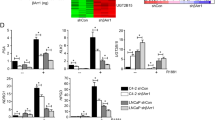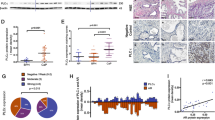Abstract
Androgen receptor (AR) has a pivotal role in the growth and survival of prostate cancer (PCa). Arrestin2 (Arr2) is a ubiquitous scaffolding/adaptor protein first characterized as a regulator of G protein-coupled receptor signaling. In this study, we report that Arr2 additionally functions as a positive regulator of AR expression and function in PCa cells. Expression level of Arr2 correlates with that of AR, and knockdown of Arr2 inhibits the expression of AR and its effectors prostate-specific antigen, transmembrane protease serine 2, FK506-binding protein 51 and fatty acid synthase. Mechanistically, the knockdown of Arr2 attenuates the binding of AR to androgen response elements and consequently decreases transcription of AR-regulated genes. The inhibition of AR by Arr2 knockdown occurs in both androgen-dependent and castration-resistant PCa (CRPC) cells, although the effect is more prominent in CRPC. Arr2 knockdown inhibits the in vitro CRPC cell proliferation, prostasphere growth and invasion, as well as the in vivo prostate tumor formation, local invasion and distant metastasis. These results illustrate a new role for Arr2 in the expression and activation of AR and its potential relevance as a target for therapeutic intervention and monitoring of disease progression.
This is a preview of subscription content, access via your institution
Access options
Subscribe to this journal
Receive 50 print issues and online access
$259.00 per year
only $5.18 per issue
Buy this article
- Purchase on Springer Link
- Instant access to full article PDF
Prices may be subject to local taxes which are calculated during checkout





Similar content being viewed by others
References
Siegel R, Naishadham D, Jemal A . Cancer statistics, 2013. CA Cancer J Clin 2013; 63: 11–30.
Attard G, Richards J, de Bono JS . New strategies in metastatic prostate cancer: targeting the androgen receptor signaling pathway. Clin Cancer Res 2011; 17: 1649–1657.
Chen Y, Sawyers CL, Scher HI . Targeting the androgen receptor pathway in prostate cancer. Curr Opin Pharmacol 2008; 8: 440–448.
Debes JD, Tindall DJ . Mechanisms of androgen-refractory prostate cancer. N Engl J Med 2004; 351: 1488–1490.
Chen CD, Welsbie DS, Tran C, Baek SH, Chen R, Vessella R et al. Molecular determinants of resistance to antiandrogen therapy. Nat Med 2004; 10: 33–39.
Saraon P, Jarvi K, Diamandis EP . Molecular alterations during progression of prostate cancer to androgen independence. Clin Chem 2011; 57: 1366–1375.
Lamont KR, Tindall DJ . Androgen regulation of gene expression. Adv Cancer Res 2010; 107: 137–162.
Matsumoto T, Sakari M, Okada M, Yokoyama A, Takahashi S, Kouzmenko A et al. The androgen receptor in health and disease. Annu Rev Physiol 2013; 75: 201–224.
Mangelsdorf DJ, Thummel C, Beato M, Herrlich P, Schutz G, Umesono K et al. The nuclear receptor superfamily: the second decade. Cell 1995; 83: 835–839.
Lefkowitz RJ, Whalen EJ . βArrestins: traffic cops of cell signaling. Curr Cin Cell Biol 2004; 16: 162–168.
Witherow DS, Garrison TR, Miller WE, Lefkowitz RJ . βArrestin inhibits NF-κB activity by means of its interaction with the NF-κB inhibitor IκBα. Proc Natl Acad Sci USA 2004; 101: 8603–8607.
Chen W, Kirkbride KC, How T, Nelson CD, Mo J, Frederick JP et al. βArrestin2 mediates endocytosis of type III TGF-β receptor and down-regulation of its signaling. Science 2003; 301: 1394–1397.
Ma L, Pei G . βArrestin signaling and regulation of transcription. J Cell Sci 2007; 120: 213–218.
Lakshmikanthan V, Zou L, Kim JI, Michal A, Nie Z, Messias NC et al. Identification of βArrestin2 as a corepressor of androgen receptor signaling in prostate cancer. Proc Natl Acad Sci USA 2009; 106: 9379–9384.
Chen W, ten Berge D, Brown J, Ahn S, Hu LA, Miller WE et al. Dishevelled 2 recruits βArrestin2 to mediate Wnt5A-stimulated endocytosis of Frizzled 4. Science 2003; 301: 1391–1394.
Wilbanks AM, Fralish GB, Kirby ML, Barak LS, Li YX, Caron MG . βArrestin2 regulates zebrafish development through the hedgehog signaling pathway. Science 2004; 306: 2264–2267.
Scott MG, Le Rouzic E, Perianin A, Pierotti V, Enslen H, Benichou S et al. Differential nucleocytoplasmic shuttling of βArrestins: characterization of a leucine-rich nuclear export signal in βArrestin2. J Biol Chem 2002; 277: 37693–37701.
Wang P, Wu Y, Ge X, Ma L, Pei G . Subcellular localization of βArrestins is determined by their intact N domain and the nuclear export signal at the C terminus. J Biol Chem 2003; 278: 11648–11653.
Buchanan FG, Gorden DL, Matta P, Shi Q, Matrisian LM, DuBois RN . Role of βArrestin1 in the metastatic progression of colorectal cancer. Proc Natl Acad Sci USA 2006; 103: 1492–1497.
Zou L, Yang R, Chai J, Pei G . Rapid xenograft tumor progression in βArrestin1 transgenic mice due to enhanced tumor angiogenesis. FASEB J 2008; 22: 355–364.
Wang LG, Su BH, Du JJ . Expression of βArrestin1 in gastric cardiac adenocarcinoma and its relation with progression. Asian Pac J Cancer Prev 2012; 13: 5671–5675.
Xiao K, McClatchy DB, Shukla AK, Zhao Y, Chen M, Shenoy SK et al. Functional specialization of βArrestin interactions revealed by proteomic analysis. Proc Natl Acad Sci USA 2007; 104: 12011–12016.
Gregory CW, Johnson RT Jr., Mohler JL, French FS, Wilson EM . Androgen receptor stabilization in recurrent prostate cancer is associated with hypersensitivity to low androgen. Cancer Res 2001; 61: 2892–2898.
Shang Y, Myers M, Brown M . Formation of the androgen receptor transcription complex. Mol Cell 2002; 9: 601–610.
Hara T, Miyazaki H, Lee A, Tran CP, Reiter RE . Androgen receptor and invasion in prostate cancer. Cancer Res 2008; 68: 1128–1135.
Vinci M, Gowan S, Boxall F, Patterson L, Zimmermann M, Court W et al. Advances in establishment and analysis of three-dimensional tumor spheroid-based functional assays for target validation and drug evaluation. BMC Biol 2012; 10: 29.
Balk SP . Androgen receptor as a target in androgen-independent prostate cancer. Urology 2002; 60: 132–138; discussion 138–139.
Feldman BJ, Feldman D . The development of androgen-independent prostate cancer. Nat Rev Cancer 2001; 1: 34–45.
Chen Y, Liu Z, Halterman DA . Molecular determinants of resistance activation and suppression by phytophthora infestans effector IPI-O. PLoS Pathogen 2012; 8: e1002595.
Boorjian SA, Heemers HV, Frank I, Farmer SA, Schmidt LJ, Sebo TJ et al. Expression and significance of androgen receptor coactivators in urothelial carcinoma of the bladder. Endocr Relat Cancer 2009; 16: 123–137.
Tilley WD, Lim-Tio SS, Horsfall DJ, Aspinall JO, Marshall VR, Skinner JM . Detection of discrete androgen receptor epitopes in prostate cancer by immunostaining: Measurement by color video image analysis. Cancer Res 1994; 54: 4096–4102.
Snoek R, Cheng H, Margiotti K, Wafa LA, Wong CA, Wong EC et al. In vivo knockdown of the androgen receptor results in growth inhibition and regression of well-established, castration-resistant prostate tumors. Clin Cancer Res 2009; 15: 39–47.
Hobisch A, Culig Z, Radmayr C, Bartsch G, Klocker H, Hittmair A . Distant metastases from prostatic carcinoma express androgen receptor protein. Cancer Res 1995; 55: 3068–3072.
Hoeppner CZ, Cheng N, Ye RD . Identification of a nuclear localization sequence in βArrestin1 and its functional implications. J Biol Chem 2012; 287: 8932–8943.
Kang J, Shi Y, Xiang B, Qu B, Su W, Zhu M et al. A nuclear function of βArrestin1 in GPCR signaling: regulation of histone acetylation and gene transcription. Cell 2005; 123: 833–847.
Shenoy SK, Han S, Zhao YL, Hara MR, Oliver T, Cao Y et al. βArrestin1 mediates metastatic growth of breast cancer cells by facilitating HIF-1-dependent VEGF expression. Oncogene 2012; 31: 282–292.
Mo W, Zhang L, Yang G, Zhai J, Hu Z, Chen Y et al. Nuclear βArrestin1 functions as a scaffold for the dephosphorylation of STAT1 and moderates the antiviral activity of IFNγ. Mol Cell 2008; 31: 695–707.
Liu YN, Liu Y, Lee HJ, Hsu YH, Chen JH . Activated androgen receptor downregulates E-cadherin gene expression and promotes tumor metastasis. Mol Cell Biol 2008; 28: 7096–7108.
Rosano L, Cianfrocca R, Tocci P, Spinella F, Di Castro V, Spadaro F et al. βArrestin1 is a nuclear transcriptional regulator of endothelin-1-induced β-catenin signaling. Oncogene 2013; 32: 5066–5077.
Friedrich J, Seidel C, Ebner R, Kunz-Schughart LA . Spheroid-based drug screen: Considerations and practical approach. Nat Protoc 2009; 4: 309–324.
Lang SH, Sharrard RM, Stark M, Villette JM, Maitland NJ . Prostate epithelial cell lines form spheroids with evidence of glandular differentiation in three-dimensional Matrigel cultures. Br J Cancer 2001; 85: 590–599.
Harma V, Virtanen J, Makela R, Happonen A, Mpindi JP, Knuuttila M et al. A comprehensive panel of three-dimensional models for studies of prostate cancer growth, invasion and drug responses. PLoS One 2010; 5: e10431.
Khaitan D, Chandna S, Arya MB, Dwarakanath BS . Establishment and characterization of multicellular spheroids from a human glioma cell line; implications for tumor therapy. J Transl Med 2006; 4: 12.
Acknowledgements
We thank Eileen Grigson and Quais Hassan for technical assistance. We also thank Dr Zhongzhen Nie for helpful comments and suggestions.
Author information
Authors and Affiliations
Corresponding author
Ethics declarations
Competing interests
The authors declare no conflict of interest.
Additional information
Supplementary Information accompanies this paper on the Oncogene website
Supplementary information
Rights and permissions
About this article
Cite this article
Purayil, H., Zhang, Y., Dey, A. et al. Arrestin2 modulates androgen receptor activation. Oncogene 34, 3144–3151 (2015). https://doi.org/10.1038/onc.2014.252
Received:
Revised:
Accepted:
Published:
Issue Date:
DOI: https://doi.org/10.1038/onc.2014.252
This article is cited by
-
Nuclear βArrestin1 regulates androgen receptor function in castration resistant prostate cancer
Oncogene (2021)
-
GRK2 enforces androgen receptor dependence in the prostate and prostate tumors
Oncogene (2020)
-
β-arrestin1/YAP/mutant p53 complexes orchestrate the endothelin A receptor signaling in high-grade serous ovarian cancer
Nature Communications (2019)
-
βArrestin2 Mediates Renal Cell Carcinoma Tumor Growth
Scientific Reports (2018)
-
β-arrestin1 at the cross-road of endothelin-1 signaling in cancer
Journal of Experimental & Clinical Cancer Research (2016)



